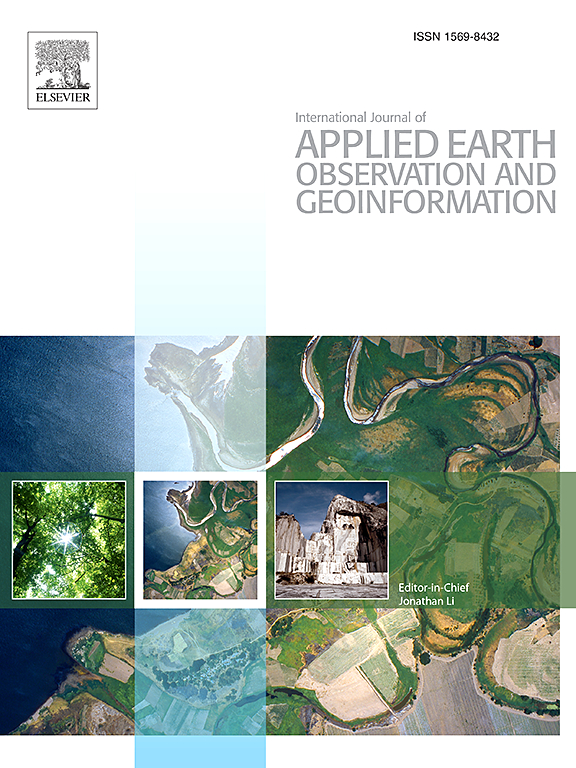Multimodal GNSS-R self-supervised learning as a generalist Earth surface monitor
IF 7.6
Q1 REMOTE SENSING
International journal of applied earth observation and geoinformation : ITC journal
Pub Date : 2025-06-21
DOI:10.1016/j.jag.2025.104658
引用次数: 0
Abstract
The increasing frequency of climate extremes and natural disasters demands rapid and scalable Earth surface scans for effective action. Emerging as a novel remote sensing technique, spaceborne global navigation satellite system reflectometry (GNSS-R) plays an increasingly vital role in monitoring Earth’s surface parameters. Recent studies leverage the growing volume of GNSS-R measurements with data-driven approaches to enhance retrieval products over both ocean and land. Yet, these models are typically trained using supervised learning, which requires extensive feature engineering and application-specific annotations. To address these limitations, we propose the first GNSS-R self-supervised learning framework as a generalist Earth surface monitor (GEM). Our model is pretrained on multimodal observables, i.e., delay-Doppler maps (DDMs) and auxiliary parametric data, to learn cross-modal representations from GNSS-R data. To validate the effectiveness of the proposed approach, we fine-tune the pretrained model on various downstream retrieval tasks, including ocean wind speed retrieval, surface soil moisture estimation, and vegetation water content prediction. The results demonstrate that our framework generalizes well across these tasks, providing a versatile solution for GNSS-R-based Earth surface monitoring and facilitating further exploration of novel use cases.
多模态GNSS-R自监督学习作为一个通用的地球表面监测
极端气候和自然灾害日益频繁,需要对地球表面进行快速和可扩展的扫描,以便采取有效行动。星载全球导航卫星系统反射测量(GNSS-R)作为一种新兴的遥感技术,在地球表面参数监测中发挥着越来越重要的作用。最近的研究利用日益增长的GNSS-R测量量和数据驱动的方法来增强海洋和陆地上的检索产品。然而,这些模型通常使用监督学习进行训练,这需要大量的特征工程和特定于应用程序的注释。为了解决这些限制,我们提出了第一个GNSS-R自监督学习框架作为通用地球表面监视器(GEM)。我们的模型在多模态观测数据(即延迟多普勒图(DDMs)和辅助参数数据)上进行预训练,以从GNSS-R数据中学习跨模态表示。为了验证该方法的有效性,我们对预训练模型进行了各种下游检索任务的微调,包括海洋风速检索、地表土壤水分估计和植被含水量预测。结果表明,我们的框架可以很好地概括这些任务,为基于gnss - r的地球表面监测提供了一个通用的解决方案,并促进了对新用例的进一步探索。
本文章由计算机程序翻译,如有差异,请以英文原文为准。
求助全文
约1分钟内获得全文
求助全文
来源期刊

International journal of applied earth observation and geoinformation : ITC journal
Global and Planetary Change, Management, Monitoring, Policy and Law, Earth-Surface Processes, Computers in Earth Sciences
CiteScore
12.00
自引率
0.00%
发文量
0
审稿时长
77 days
期刊介绍:
The International Journal of Applied Earth Observation and Geoinformation publishes original papers that utilize earth observation data for natural resource and environmental inventory and management. These data primarily originate from remote sensing platforms, including satellites and aircraft, supplemented by surface and subsurface measurements. Addressing natural resources such as forests, agricultural land, soils, and water, as well as environmental concerns like biodiversity, land degradation, and hazards, the journal explores conceptual and data-driven approaches. It covers geoinformation themes like capturing, databasing, visualization, interpretation, data quality, and spatial uncertainty.
 求助内容:
求助内容: 应助结果提醒方式:
应助结果提醒方式:


